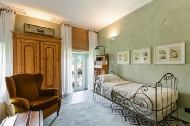Ca' Mariuccia
Albugnano (Asti)
-
Restaurant
-
Wi-Fi
-
Pets welcome
Profile
In brief
- Type: Bedroom (3),
- Guests: 9
- Map: Hills
- Type of accommodation: Room only
The agriturismo
Everything revolves around the farmhouse, a typical Piedmontese farmhouse of about 1200 square meters built between the end of 800 and early 900 and always intended for company agricultural products for hazelnut cultivation and wine production. The renovation works followed the practices and principles of participatory construction using natural materials or reusing recycled materials and involved several volunteers, enthusiasts and students who wanted to learn alternative construction methods. Also for this reason, while the renovation was still underway, we wanted to share the experience of the most interesting practices by organizing workshops held by experts on green building techniques that we were applying: straw walls and cocciopesto plasters.
The accommodation
The heart of our farm is the farmhouse, a typical Piedmontese farmhouse of about 1200 m2, built between the end of 1800 and the beginning of 1900 and always intended as a farm for animal breeding and wine production. Inside, we have created several areas reserved for reception, teaching and conviviality: rooms for bed&breakfast guests, accommodation for wwoofer volunteers, hostel for school students (S.A.N), classroom for courses and meetings, kitchen, restaurant area and a shop for the sale of our products and local products. The production of "good" food for man and the environment are the basis of our work. The spread of a new agricultural conscience, the creation of synergies between people and institutions that put the protection of the Earth and the soil at the center is our leitmotiv, as well as cooperation with the territory and with those who live it through the exchange of organic and ethical products. Respect for animals and their environment are the values at the basis of our activities. WELL-BEING at the expense of WELL-BEING. This is what we are and what we want to share.
Activities and surrounding
We offer our guests the opportunity to participate in the farm's agricultural activities that vary according to the season: work in the vineyard and in the hazelnut grove, haymaking or harvesting. We are also an excellent starting point for walks or mountain bike rides, fitness trails and bird-watching. In addition to the splendid view from the Belvedere Motta, which offers the view of vineyards, woods, villages and the peaks of the Maritime and Cottian Alps, the beautiful eighteenth-century manor houses and the ancient Romanesque church of San Pietro, Albugnano houses the famous Abbey of Vezzolano. Founded at the end of the 11th century, the complex of the Canonica di Santa Maria di Vezzolano represents a real jewel of Romanesque-Gothic art, a magnificent work of art of great historical importance that can be reached from the church of San Pietro through a pleasant route immersed in nature. Near Albugnano, the municipality of Castelnuovo Don Bosco offers visitors elegant noble palaces, baroque churches (Sant'Andrea and the church of the Castle) located in the historic centre above the Rivalba tower, Romanesque churches (Santa Maria di Cornareto and Sant'Eusebio) that dot the hills and, of course, the birthplace of San Giovanni Bosco with the temple dedicated to him, the Salesian Missionary Museum and the Farming Museum. For lovers of nature and outdoor walks, but also of good food, there are many areas of interest around Albugnano. The presence of an articulated network of roads, country roads and paths offers the opportunity for pleasant excursions on foot or by bicycle, also following the routes proposed by the Roads of Colours and Flavours. The itineraries, which cross the many small villages in the hills, provide useful suggestions for the stages in restaurants and wineries where you can taste the excellent local wines. Those who want to experience a leap in time, to discover the places that preserve the faith and Christian art, can take the Via Francigena, among whose milestones appears the Abbey of Vezzolano. Famous pilgrimage route dating back to the Middle Ages, ideally developed between Canterbury and Rome, the Via Francigena has been over the centuries an important route of communication and pilgrimage along which circulated artistic influences and occurred cultural and commercial exchanges. Today it represents an opportunity for believers and non-believers to explore the territory from a different point of view.
Services
Available services
Inform the agriturismo of any animals at the time of booking.
Owners will be held responsible for damage to property and persons.
Pets allowed
- Dogs
- Cats
Size/gender of dogs
- Medium (10 kg - 25 kg)
Allowed in
- Accommodation
- Restaurant
- Public areas
Safety
- Only well-behaved, supervised animals
- Must be kept on a lead in public areas
- Must be kept on a lead outside
Services
- Bowls for food and water
- Nature Reserves
- Museums and galleries
- Artistic and historical sites
- Hiking
- Bird watching
- Horse riding
- Golf
(T... Read more


